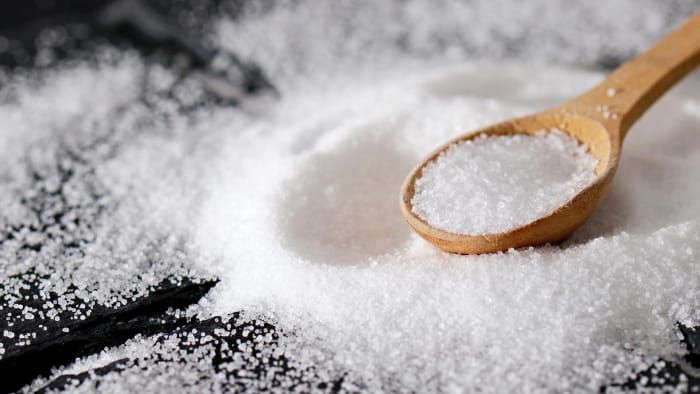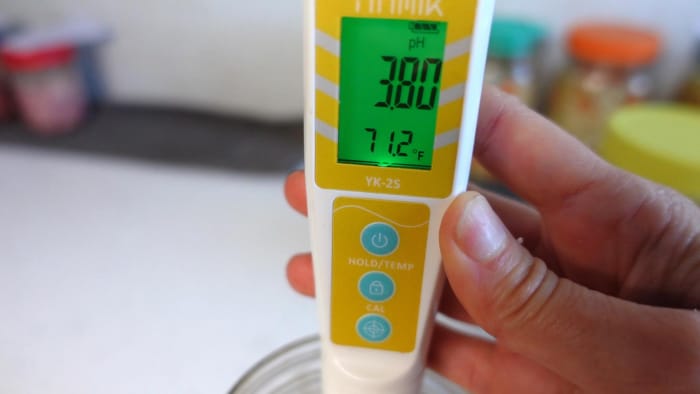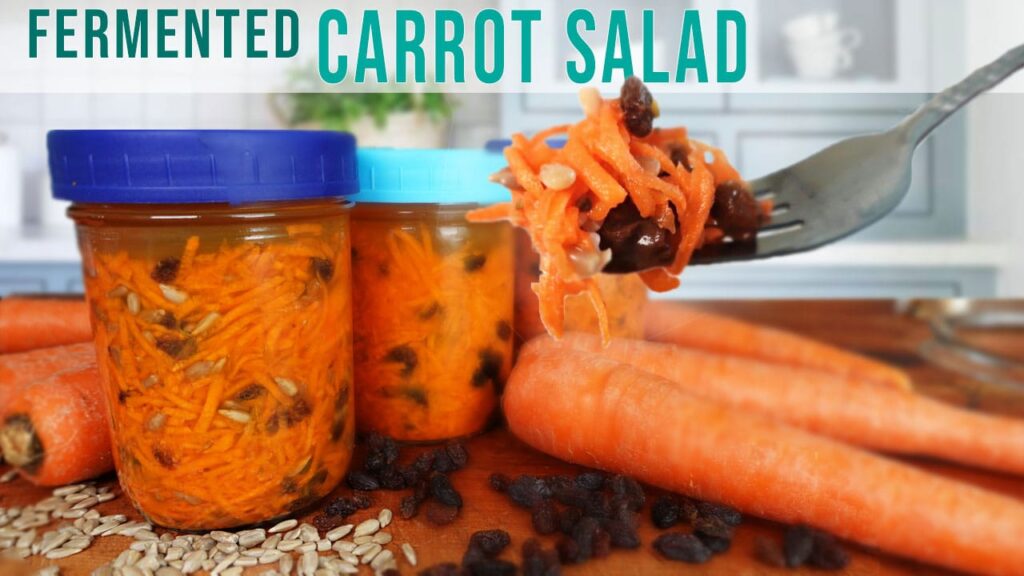
This “safety guidelines when fermenting vegetables” post contains affiliate links. Please read my affiliate disclosure.
5 Essential Safety Guidelines You Must Know
Whether you’re a beginner or seasoned fermenter, it’s important to practice the 5 essential safety guidelines involving this food-transformative process.
When flying an aircraft or constructing a building, it’s necessary to acquire the appropriate knowledge to prevent the plane from crashing or the house from collapsing. Similarly in the context of fermenting foods, knowledge is needed to ensure a safe fermentation process.
If safety measures are not followed, harmful bacteria and molds can contaminate the food which can lead to foodborne illness.
In this article, I will walk you through the top 5 safety guidelines when fermenting vegetables to ensure that your fermentation journey is not only flavorful & nutritious, but also safe.
Even More Visual Examples Provided In The Video:
If you are a visual learner, watch the video below where I provide demonstrations and more details regarding this topic. Or watch on YouTube.

Safety Guideline #1
Cleanliness of the Equipment
One of the most crucial aspects of fermenting safety is ensuring the cleanliness of the equipment. Before starting, thoroughly clean all the utensils, jars, and containers that will come into contact with the vegetables and brine. This will remove any unseen fingerprints or other contaminants that would love to host mold or pathogens.

To clean the equipment, wash everything in hot soapy water, paying extra attention to remove any food residue or oils. Then rinse in hot water thoroughly to remove the soap residue. Sterilization is not mandatory to ensure clean and safe equipment, washing in hot soapy water is sufficient.
However for some, washing alone doesn’t ease their concerns. If this is you, feel free to sanitize the equipment by placing it in boiling water for a few minutes. Alternatively, you can use a food-grade sanitizer or run the equipment through the dishwasher on the sanitize cycle.
Note: When fermenting vegetables, use either glass or food-grade plastic containers. It’s best to avoid metals such as aluminum, iron or copper because they can react with the acids produced during fermentation.
Safety Guideline #2
Salt
Salt creates an environment that is inhospitable to bad pathogens while not adversely affecting the good bacteria (probiotics). I call this nature’s perfect design!

When fermenting vegetables, it is crucial to use the right amount of salt. If too little salt is used, it will result in the growth of harmful bacteria, resulting in fermented food that is not safe to eat. On the other hand, too much salt can make the fermented food unpalatable.
A general guideline is to use approximately 2-3% salt by weight of the vegetables. Therefore, be sure to follow the recipe salt measurements provided by trusted sources to ensure the correct salt ratio. In my fermentation recipes, I calculate the right amount of salt to use so you don’t have to!
Note About Salt:
When fermenting vegetables, use a salt that does not contain anti-caking agents. Why? Because those anti-caking chemicals can inhibit the growth of the beneficial bacteria, causing the fermentation to fail. Read the ingredient label of the salt to ensure it says “salt” and only salt.
Shop my favorite fermenting salts by clicking here.
Safety Guideline #3
Brine
Brine is a simple yet crucial part of vegetable fermentation. It consists of only two ingredients, salt and water. The salt and water are combined, thoroughly mixed, and then poured over the vegetables in the jar. The salt inhibits the bad pathogens as discussed in safety guideline #2. Whereas the water adds to the inhibition of bad pathogens by creating an oxygen-free environment.
An oxygen-free environment is important because the good bacteria are anaerobic, meaning they do not require oxygen for survival. The bad pathogens however, are aerobic, meaning they do need oxygen for survival. So when the brine pushes out the oxygen, the bad bacteria will die-off.
Follow the vegetable fermentation recipe to ensure the correct ratio of salt and water. When pouring the brine over the food in the jar, be sure to cover all the ingredients in order to prevent the growth of harmful pathogens. If any food remains above the brine, it is at risk of developing pathogens or mold due to the oxygen exposure.

Safety Guideline #4
Fermenting Weight
Using a fermenting weight is an important safety measure during vegetable fermentation. The weight keeps the vegetables fully submerged beneath the brine throughout the entire fermenting period. Without a fermenting weight, there is a risk of mold growth or spoilage due to the exposure to the surface oxygen.

There are various types of fermenting weights available, including glass weights, ceramic weights, and even simple food-grade plastic bags filled with brine. The choice of fermenting weight depends on personal preference and availability.
Remember to wash the weight in hot soapy water before placing it on top of the vegetables in the jar. Make that the weight covers the entire surface area of the vegetables and provides an even distribution of pressure. This ensures that the vegetables stay submerged in the brine which creates a favorable environment for the beneficial bacteria responsible for the fermentation.
Notes About The Fermenting Weight
Some glass fermenting weights out there use less glass in the product which make them quite light. Unfortunately, ‘light’ weights don’t sufficiently hold the food down beneath the brine for the entire length of the fermentation period. This is of course, no good!
That is why these are the specific glass fermentation weights I recommend and personally use. They are lead free and heavier than other glass fermenting weights, ensuring they do their job effectively!
If you do not have access to glass fermenting weights, watch my video below on DIY Fermentation Weight Ideas.

Safety Guideline #5
pH Levels
Monitoring pH levels during vegetable fermentation is crucial for safety. pH is a measure of the acidity or alkalinity of a solution and plays a significant role in the fermentation process. It helps to inhibit the growth of harmful bacteria while promoting the growth of the beneficial.
Ideally, a vegetable fermentation pH reading is between 3 and 4. This low level of acidity helps create an environment that is unfavorable for the growth of harmful bacteria while the beneficial bacteria don’t mind at all. To monitor pH levels, use a digital pH meter or pH test strips to take a reading of the fermenting food.

Regularly monitor the pH levels throughout the fermentation process, especially during the initial stages. If the pH levels are above 4.5 after day 5 of the fermentation process, it could indicate the growth of harmful bacteria.
If you have interest in a pH tester but aren’t sure which one is right for you, watch my video below so that you can make an informed purchase.

Summing Up…
Vegetable fermentation can be a safe and enjoyable way to preserve and enhance the health properties of your favorite vegetables. By following these 5 safety guidelines, you can ensure a successful and safe fermentation process.
Remember to refer to trusted sources and recipes for specific guidelines and saltwater ratios to maximize the safety and deliciousness of your fermented vegetables. Happy fermenting!
P.S.
Are you new to fermenting? Even though you’ve followed these 5 safety guidelines, do you still feel uncertain about whether or not your ferment is safe to eat? I can help! Follow my 4-point checklist that will walk you through each step to determine if your fermentation creation is safe to eat or not!










